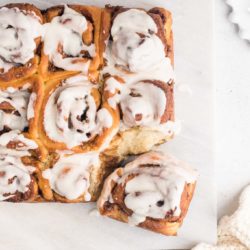Cinnamon Rolls

- Resting Time: 2 hours
- Prep Time: 60 mins
- Cook Time: 30 mins
- Total Time: 1 hour 30 minutes
- Yield: Makes 9 buns
- Category: Bread
- Method: Oven
- Cuisine: American
Soft and fluffy Cinnamon Rolls made from a brioche-like dough, and drizzled with a simple icing for a touch of indulgence. Easy recipe for Cinnamon Rolls with step-by-step photos.
Ingredients
For the Dough
- 400 g (2 2/3 cup) white bread flour
- 75 g (1/3 cup) caster sugar
- 1/2 teaspoon fine salt
- 9 g instant dried yeast (see Kitchen Notes below)
- 1 egg, at room temperature
- 250 ml (1 cup) milk, warmed to 37°C/98°F
- 45 g (3 tablespoons) unsalted butter, softened
For the Cinnamon-Sugar Filling
- 100 g (1 stick) unsalted butter, softened
- 100 g (1/2 cup plus 1 tablespoon) soft brown sugar or light muscovado sugar
- 2 teaspoons ground cinnamon
- 1/4 teaspoon fine salt
For the Icing
- 135 g (1 cup) icing sugar (powdered sugar)
- 2 tablespoons milk
- 1 tablespoon unsalted butter, softened
Instructions
You will need approx. 3 hours to make the Cinnamon Rolls
For the Dough
- Measure the flour, sugar, salt and yeast into the bowl of an electric stand mixer.
- Lightly mix the ingredients together using the dough hook.
- Add the egg to the bowl.
- Slowly pour in the warm milk, and continue mixing until everything comes together into a rough dough.
- Add the butter, one tablespoon at a time. Once the butter has been fully incorporated into the dough, add the next tablespoon of butter.
- Once all of the butter has been added, continue kneading the dough on medium speed for about 15 to 20 minutes.
- The dough is ready when it is soft and smooth, and no longer sticks to the side of the bowl. The dough will be somewhat sticky from the butter and egg.
For the First Proofing Session
- Lightly oil a large mixing bowl.
- Place the dough inside the bowl.
- Cover the dough with a clean tea towel, plastic wrap, or a reusable bowl cover.
- Leave the dough somewhere warm for 1 to 1.5 hours, or until the dough has doubled in size (see Kitchen Notes below).
For the Cinnamon-Sugar Filling
- Just before the dough is ready, make the filling by beating together the ingredients.
To Shape the Cinnamon Rolls
- Line a 20 cm/8 inch square baking pan with baking paper.
- Once the dough has doubled in size, gently remove the dough from the bowl. The dough will deflate as you handle it.
- Roll out the dough into a rectangle shape measuring approximately 40 x 30 cm/16 x 12 inches.
- Use a small palette knife to evenly spread the filling all over the dough.
- Roll up the dough tightly from the short end, i.e. to produce a log that is 30 cm/12 inches long.
- Cut the dough into 9 even pieces. I find it easiest to do so using a long piece of unflavoured dental floss, which will allow you to slice through the dough cleanly and sharply, and without flattening the dough. Simply slide the floss under the dough, then pull both ends of the floss across each other, which will cut through the dough as you pull.
- Arrange the slices of dough in the baking pan.
For the Second Proofing Session
- Place the pan somewhere warm for about 30 minutes, or until the buns have risen and puffed up slightly.
To Bake the Cinnamon Rolls
- Preheat the oven to 200°C/390°F (without fan) with a metal baking tray on the middle shelf.
- Place the pan of buns on the preheated baking tray.
- Bake the buns for 10 minutes.
- Reduce the heat to 180°C/356°F and bake for another 20 minutes, or until the buns are lightly golden. Check the buns at about 10 minutes, and if they are browning too quickly, cover them with a loose sheet of foil for the rest of the baking time.
- The buns are cooked if an internal thermometer reads 85°C/185°F.
- Gently remove the buns (intact) to a wire rack, and leave them to cool completely.
To Ice the Cinnamon Rolls
- Make the icing by whisking together the ingredients. Add the milk gradually until the icing is a thick, but runny, consistency.
- Drizzle the icing all over the cooled Cinnamon Rolls.
- The Cinnamon Rolls can be served immediately or once the icing has set. They are best eaten the same day they are baked.
Kitchen Notes
 MAKE AHEAD TIPS
MAKE AHEAD TIPS
To make the Cinnamon Rolls the night before:
* Make the dough as per the recipe until it has doubled in size. Without deflating the dough, place it in the fridge to continue proving overnight. The next day, proceed with the rest of the recipe.
* Alternatively, complete all of the steps until you have assembled the 9 pieces of rolled dough in the baking pan. Cover the pan with some plastic wrap, and leave in the fridge to prove overnight. The buns will rise and puff up overnight in the fridge. Before you are ready to bake, take the pan out of the fridge and let the dough come back to room temperature (this should take about 30 minutes). Proceed with the rest of the recipe.
 MAKE A LARGER BATCH
MAKE A LARGER BATCH
To adjust the recipe to make 12 buns, use the following quantities:
For the Dough:
600 g (4 cups) strong white bread flour
110 g (1/2 cup) caster sugar
1 teaspoon fine salt
14 g (4 teaspoons) instant dried yeast
1 egg
375 ml (1 1/2 cup) milk
60 g (4 tablespoons) unsalted butter
For the Cinnamon-Sugar Filling:
125 g (1 1/4 stick) unsalted butter
125 g (3/4 cup) light brown sugar
3 teaspoons ground cinnamon
1/4 teaspoon fine salt
Instructions
Roll the dough into a rectangle shape, measuring approx 50 x 30 cm/20 x 12 inches. Roll up the dough tightly from the long end, i.e. to produce a log that is 50 cm/20 inches long. Cut the dough into 12 even pieces.
 BAKE IN A ROUND DISH
BAKE IN A ROUND DISH
To bake the Cinnamon Rolls in a 25cm/10 inch round baking dish or cake pan, cut 8 slices from the dough.
 DIFFERENT TYPES OF FLOUR
DIFFERENT TYPES OF FLOUR
* For Swiss readers: I use Zopfmehl (or farine pour tresse) when making bread and enriched dough.
 DIFFERENT TYPES OF YEAST
DIFFERENT TYPES OF YEAST
* Please note that there is a difference between instant yeast (also called instant dried yeast or fast-action dried yeast) and dried yeast (also called active dry yeast). If you are not sure what type of yeast you have, please check the packaging for instructions on how to use the yeast.
* With instant yeast, you can add it directly to the flour mixture without having to activate it first.
* With dried yeast, you will need to activate it first (usually in some warm liquid).
* If you are using fresh yeast, you will need about half a block (40 g fresh yeast = 14 g instant dried yeast). Crumble the fresh yeast into the warm milk, and stir to dissolve the yeast.
 PROOFING THE DOUGH
PROOFING THE DOUGH
Dough needs a warm environment for the yeast to activate and cause the dough to rise. If you don’t have a warm place in your home, try one of the following ideas:
* In the oven with the oven light switched on (works only for some ovens).
* In the oven with a tray of boiling water on the bottom shelf.
* In the oven or a steamer oven at a low temperature of about 25-40°C (77-104°F).
 OVEN TEMPERATURES
OVEN TEMPERATURES
All recipes on this website state temperatures for a regular oven (i.e. a conventional oven without fan). If you have a convection oven with a fan, please consult the manufacturer’s handbook on how to adjust the temperature and baking time accordingly.
 CONVERSIONS
CONVERSIONS
To convert from cups to grams, and vice-versa, please see this handy Conversion Chart for Basic Ingredients.
View the recipe online: https://eatlittlebird.com/cinnamon-rolls/


